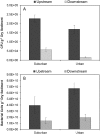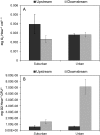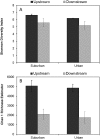Wastewater treatment effluent reduces the abundance and diversity of benthic bacterial communities in urban and suburban rivers
- PMID: 23315724
- PMCID: PMC3592216
- DOI: 10.1128/AEM.03527-12
Wastewater treatment effluent reduces the abundance and diversity of benthic bacterial communities in urban and suburban rivers
Abstract
In highly urbanized areas, wastewater treatment plant (WWTP) effluent can represent a significant component of freshwater ecosystems. As it is impossible for the composition of WWTP effluent to match the composition of the receiving system, the potential exists for effluent to significantly impact the chemical and biological characteristics of the receiving ecosystem. We assessed the impacts of WWTP effluent on the size, activity, and composition of benthic microbial communities by comparing two distinct field sites in the Chicago metropolitan region: a highly urbanized river receiving effluent from a large WWTP and a suburban river receiving effluent from a much smaller WWTP. At sites upstream of effluent input, the urban and suburban rivers differed significantly in chemical characteristics and in the composition of their sediment bacterial communities. Although effluent resulted in significant increases in inorganic nutrients in both rivers, surprisingly, it also resulted in significant decreases in the population size and diversity of sediment bacterial communities. Tag pyrosequencing of bacterial 16S rRNA genes revealed significant effects of effluent on sediment bacterial community composition in both rivers, including decreases in abundances of Deltaproteobacteria, Desulfococcus, Dechloromonas, and Chloroflexi sequences and increases in abundances of Nitrospirae and Sphingobacteriales sequences. The overall effect of the WWTP inputs was that the two rivers, which were distinct in chemical and biological properties upstream of the WWTPs, were almost indistinguishable downstream. These results suggest that WWTP effluent has the potential to reduce the natural variability that exists among river ecosystems and indicate that WWTP effluent may contribute to biotic homogenization.
Figures





References
-
- US EPA. 2009. Drinking water infrastructure needs survey and assessment: fourth report to Congress, p 1–12 US EPA, Washington, DC
-
- Brooks BW, Riley TM, Taylor RD. 2006. Water quality of effluent-dominated ecosystems: ecotoxicological, hydrological, and management considerations. Hydrobiologia 556:365–379
-
- Illinois Department of Natural Resources 2011. Illinois Coastal Management Program issue paper: Chicago River and North Shore Channel corridors. Illinois Department of Natural Resources, Springfield, IL
-
- Waiser MJ, Tumber V, Holm J. 2011. Effluent-dominated streams. Part 1: presence and effects of excess nitrogen and phosphorus in Wascana Creek, Saskatchewan, Canada. Environ. Toxicol. Chem. 30:496–507 - PubMed
-
- Gücker B, Brauns M, Pusch MT. 2006. Effects of wastewater treatment plant discharge on ecosystem structure and function of lowland streams. J. North Am. Benthol. Soc. 25:313–329
Publication types
MeSH terms
Substances
LinkOut - more resources
Full Text Sources
Other Literature Sources
Research Materials

